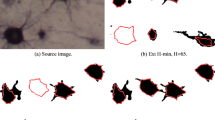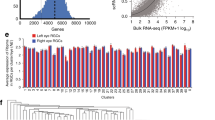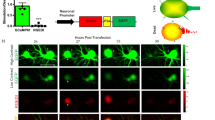Abstract
Quantification of cells is a critical step towards the assessment of cell fate in neurological disease or developmental models. Here, we present a novel cell detection method for the automatic quantification of zebrafish neuronal cells, including primary motor neurons, Rohon–Beard neurons, and retinal cells. Our method consists of four steps. First, a diffused gradient vector field is produced. Subsequently, the orientations and magnitude information of diffused gradients are accumulated, and a response image is computed. In the third step, we perform non-maximum suppression on the response image and identify the detection candidates. In the fourth and final step the detected objects are grouped into clusters based on their color information. Using five different datasets depicting zebrafish cells, we show that our method consistently displays high sensitivity and specificity of over 95%. Our results demonstrate the general applicability of this method to different data samples, including nuclear staining, immunohistochemistry, and cell death detection.













Similar content being viewed by others
References
Avanesov , A., Dahm, R., Sewell, W. F., & Malicki, J. J. (2005). Mutations that affect the survival of selected amacrine cell subpopulations define a new class of genetic defects in the vertebrate retina. Developmental Biology, 285, 138–155.
Baier, H., Klostermann, S., Trowe, T., Karlstrom, R., Nusslein-Volhard, C., & Bonhoeffer, F. (1996). Genetic dissection of the retinotectal projection. Development, 123, 415–425.
Belien, J. A. M., Ginkel, H. A. H. M., Tekola, P., Ploeger, L. S., Poulin, N. M., Baak, J. P. A., et al. (2002). Confocal DNA cytometry: A contour-based segmentation algorithm for automated three-dimensional image segmentation. Cytometry, 49, 12–21.
Byun, J., Verardo, M. R., Sumengen, B., Lewis, G. P., Manjunath, B. S., & Fisher, S. K. (2006). Automated tool for the detection of cell nuclei in digital microscopic images: Application to retinal images. Molecular Vision, 12, 949–960.
Cambell, W. A., Yang, H., Zetterberg, H., Baulac, B., Liu, T., Wong, S. T., et al. (2006). Zebrafish lacking Alzheimer presenilin enhancer 2 (Pen-2) demonstrate excessive p53-dependent apoptosis and neuronal loss. Journal of Neurochemistry, 96, 1423–1440.
Caselles, V., Kimmel, R., & Sapiro, G. (1997). Geodesic active contours. International Journal of Computer Vision, 22, 61–79.
Chang, H., & Parvin, B. (2006). Segmentation of three dimensional cell culture models from a single focal plane. International Symposium on Visual Computing, 2006.
Chen, X., Zhou, X., & Wong, S. T. (2006). Automated segmentation, classification, and tracking of cancer cell nuclei in time-lapse microscopy. IEEE Transactions on Biomedical Engineering, 53, 762–766.
Comaniciu, D., & Meer, P. (2002). Mean shift: A robust approach toward feature space analysis. IEEE Transactions on Pattern Analysis and Machine Intelligence, 24, 603–619.
Comanicu, D., Ramesh, V., & Meer, P. (2003). Kernel-based object tracking. IEEE Transactions on Pattern Analysis and Machine Intelligence, 25, 564–577.
Davatzikos, C., Prince, J. L., & Bryan, R. N. (1996). Image registration based on boundary mapping. IEEE Transactions on Medical Imaging, 15, 112–115.
Dougherty, E. R., & Lotufo, R. (2003). Hands-on morphological image processing. SPIE PRESS Vol. TT59.
Dufour, A., Shinin, V., Tajbakhsh, S., Guillen-Aghion, N., Olivo-Marin, J. C., & Zimmer, C. (2005). Segmentation and tracking fluorescent cells in dynamic 3-D microscopy with coupled active surfaces. IEEE Transactions on Image Processing, 1 4, 1396–1410.
Feng, J., Ip, H. H., Cheng, S. H., & Chan, P. K. (2004). A relational-tubular (ReTu) deformable model for vasculature quantification of zebrafish embryo from microangiography image series. Computerized Medical Imaging and Graphics, 28, 333–344.
Garrido, A., & de la Blanca, N. P. (2000). Applying deformable templates for cell image segmentation. Pattern Recognition, 33, 821–832.
Kachouie, N. N., Lee, L. J., & Fieguth, P. W. (2005). A probabilistic living cell segmentation model, ICIP05.
Kass, M., Witkin, A., & Terzopoulos, D. (1988). Snakes: Active contour models. International Journal of Computer Vision, 1, 321–331.
Kato, S., Nakagawa, T., Ohkawa, M., Muramoto, K., Oyama, O., Watanabe, A., et al. (2004). A computer image processing system for quantification of zebrafish behavior. Journal of Neuroscience Methods, 134, 1–7.
Kimmel, C. B., Ballard, W. W., Kimmel, S. R., Ullmann B., Schilling, T. (1995). Stages of embryonic development of the zebrafish. Developmental Dynamics, 203, 253–310.
Lehmussola, A., Ruusuvuori, P., Selinummi, J., Huttunen, H., & Yli-Harja, O. (2007). Computational frameworks for simulating fluorescence microscope images with cell populations. IEEE Transactions on Medical Imaging, 26, 1010–1016.
Li, K., Miller, E. D., Weiss, L. E., Campbell, P. G., & Kanade, T. (2006). Online tracking of migrating and proliferating cells imaged with phase-contrast microscopy, MMBIA06.
Lin, G., Adiga, U., Olson, K., Guzowski, J., Barnes, C., & Roysam, B. (2003). A hybrid 3-D watershed algorithm incorporating gradient cues and object models for automatic segmentation of nuclei in confocal image stacks. Cytometry, 56A, 23–36.
Lin, G., Chawla, M. K., Olson, K., Barnes, C. A., Guzowski, J. F., Bajornsson, C., et al. (2007). A multi-model approach to simultaneous segmentation and classification of heterogeneous populations of cell nuclei in 3D confocal microscope images. Cytometry, 71A, 724–736.
Lin, G., Chawla, M. K., Olson, K., Guzowski, J. F., Barnes, C. A., & Roysam, B. (2005). Hierarchical, model-based merging of multiple fragments for improved 3-D segmentation of nuclei. Cytometry, 63A, 20–33.
Liu, T., Lu, J., Wang, Y., Campbell, W. A., Huang, L., Zhu, J., et al. (2006). Computerized image analysis for quantitative neuronal phenotyping in zebrafish. Journal of Neuroscience Methods, 153, 190–202.
Loukas, C. G., Wilson, G. D., Vojnovic, B., & Linney, A. (2003). An image analysis-based approach for automated counting of cancer cell nuclei in tissue sections. Cytometry, 55, 30–42.
Loy, G., & Zelinsky, A. (2003). Fast radial symmetry for detecting points of interest. IEEE Transactions on Pattern Analysis and Machine Intelligence, 25, 959–973.
Malicki, J. (2000). Harnessing the power of forward genetics—analysis of neuronal diversity and patterning in the zebrafish retina. Trends in Neurosciences, 23, 531–541.
Malicki, J., Neuhauss, S. C., Schier, A. F., Solnica-Krezel, L., Stemple, D. L., Stainier, D. Y., et al. (1996). Mutations affecting development of the zebrafish retina. Development, 123, 263–273.
Malpica, N., Ortiz de Solorzano, C., Vaquero, J. J., Santos, A., Vallcorba, I., Garcia-Sagredo, J. M., et al. (1997). Applying watershed algorithms to the segmentation of clustered nuclei. Cytometry, 28, 289–297.
Manjunath, B. S., Sumengen, B., Bi, Z., Byun, J., Saban, M. A., Fedorov, D. G., et al. (2006). Towards automated bioimage analysis: From features to semantics. ISBI, 255–258.
Nath, S. K., Bunyak, F., & Palaniappan, K. (2006). Robust tracking of migrating cells using four-color level set segmentation. In Advanced concepts for intelligent vision systems ‘06 (pp. 920–932). Berlin: Springer.
Nilsson, B., & Heyden, A. (2005). Segmentation of complex cell clusters in microscopic image: Application to bone marrow samples. Cytometry, 66A, 24–31.
Ortiz de Solorzano, C., Malladi, R., Lelievre, S. A., & Lockett, S. J. (2001). Segmentation of nuclei and cells using membrane related protein markers. Journal of Microscopy, 201, 404–415.
Parvin, B., Yang, Q., Han, J., Chang, H., Rydberg, B., & Barcellos-Hoff, M. (2007). Iterative voting for inference of structural saliency and characterization of subcellular events. IEEE Transaction on Image Processing, 16, 615–623.
Price, J. H., Hunter, E. A., & Gough, D. A. (1998). Accuracy of least squares designed spatial FIR filters for segmentation of images of fluorescence stained cell nuclei. Cytometry, 25, 303–316.
Raman, S., Maxwell, C. A., Barcellos-Hoff, M. H., et al. (2007). Geometric approach to segmentation and protein localization in cell culture assays. Journal of Microscopy, 225(1), 22–30.
Ranzato, M., Taylor, P. E., House, J. M., Flagan, R. C., Le Cun, Y. L., & Perona, P. (2007). Automatic recognition of biological particles in microscopic images. Pattern Recognition Letters, 28(1), 31–39.
Sarti, A., de Solorzano, C. O., Locket, S., & Malladi, R. (2000). A geometric model for 3-D confocal image analysis. IEEE Transactions on Biomedical Engineering, 47, 1600–1609.
Sbalzarini, I. F., & Koumoutsakos, P. (2005). Feature point tracking and trajectory analysis for video imaging in cell biology. Journal of Structural Biology, 151, 182–1955.
Schulz, J., Schmidt, T., Ronneberger, O., Burkhardt, H., Pasternak, T., Dovzhenko, A., et al. (2006) Fast scalar and vectorial grayscale based invariant features for 3D cell nuclei localization and classification, DAGM 2006.
Shah, S. (2007). Segmenting biological particles in multispectral microscopy images. Applications of Computer Vision, 44.
Shain, W., Kayali, S., Szarowski, D., Davis-Cox, M., Ancin, H., Bhattacharjya, A. K., et al. (1999). Application and quantitative validation of computer-automated three-dimensional counting of cell nuclei. Microscopy and Microanalysis, 5, 106–119.
Shitong, W., & Min, W. (2006). A new detection algorithm (NDA) based on fuzzy cellular neural networks for white blood cell detection. IEEE Transactions on Information Technology in Biomedicine, 10, 5–10.
Sjostrom, P. J., Frydel, B. R., & Wahlberg, L. U. (1999). Artificial neural network-aided image analysis system for cell counting. Cytometry, 36, 18–26.
Solorzano, C., & Rodriguez, E. (1999). Segmentation of confocal microscope images of cell nuclei in thick tissue sections. Journal of Microscopy, 193, 212–226.
Thisse, C., Thisse, B., Schilling, T. F., & Postlethwait, J. H. (1993). Structure of the zebrafish snail1 gene and its expression in wild-type, spadetail and no tail mutant embryos. Development, 119, 1203–1215.
Umesh , P. S., & Chaudhuri, B. B. (2001). An efficient method based on watershed and rule-based merging for segmentation of 3-D histo-pathological images. Pattern Recognition, 34, 1449–1458.
Vincent, L., & Soille, P. (1991). Watersheds in digital spaces: An efficient algorithm based on immersion simulations. IEEE Transactions on Pattern Analysis and Machine Intelligence, 13, 583–598.
Wahlby, C., Sintorn, I. M., Erlandsson, F., Borgefors, G., & Bengtsson, E. (2004). Combining intensity, edge and shape information for 2D and 3D segmentation of cell nuclei in tissue sections. Journal of Microscopy, 215, 67–76.
Wu, H. S., Barba, J., & Gil, J. (1998). A parametric fitting algorithm for segmentation of cell images. IEEE Transactions on Biomedical Engineering, 45, 400–407.
Wu, H. S., Barba, J., & Gil, J. (2000). Iterative thresholding for segmentation of cell images. Journal of Microscopy, 197, 296–304.
Wu, K., Gauthier, D., & Levine, M. D. (1995). Live cell image segmentation. IEEE Transactions on Biomedical Engineering, 42, 1–12.
Xiong, G., Zhou, X., Ji, L., Bradley, P., Perrimon, N., & Wong, S. (2006). Segmentation of Drosophila RNAI fluorescence images using level sets, ICIP06.
Xu, C., & Prince, J. L. (1998). Snakes, shapes, and gradient vector flow. IEEE Transactions on Image Processing, 7, 359–369.
Yang, Q., & Parvin, B. (2003). Harmonic cut and regularized centroid transform for localization of subcellular structures. IEEE Transactions on Biomedical Engineering, 50, 469–475.
Zetterberg, H., Campbell, W. A., Yang, H. W., & Xia, W. (2006). The cytosolic loop of the g-secretase component presenilin enhancer 2 (Pen-2) protects zebrafish embryos from apoptosis. Journal of Biological Chemistry, 281, 11933–11939.
Zimmer, C., Labruyere, E., Meas-Yedid, V., Guillen, N., & Olivo-Marin, J. C. (2002). Segmentation and tracking of migrating cells in videomicroscopy with parametric active contours: A tool for cell-based drug testing. IEEE Transactions on Medical Imaging, 21, 1212–1221.
Acknowledgements
The software and sample dataset used in this paper are released at the website: http://www.cbi-platform.net/. We would like to thank Dr. William Campbell, Jacqueline Sears and Melvin Zhang for zebrafish image acquisition and analysis, and thank Dr. Scott Holley for providing the zebrafish images in Fig. 11. This work is funded by the NIH AG015379 (WX) and a Bioinformatics Research Center Program Grant from HCNR (STCW).
Author information
Authors and Affiliations
Corresponding author
Rights and permissions
About this article
Cite this article
Liu, T., Li, G., Nie, J. et al. An Automated Method for Cell Detection in Zebrafish. Neuroinform 6, 5–21 (2008). https://doi.org/10.1007/s12021-007-9005-7
Received:
Accepted:
Published:
Issue Date:
DOI: https://doi.org/10.1007/s12021-007-9005-7




